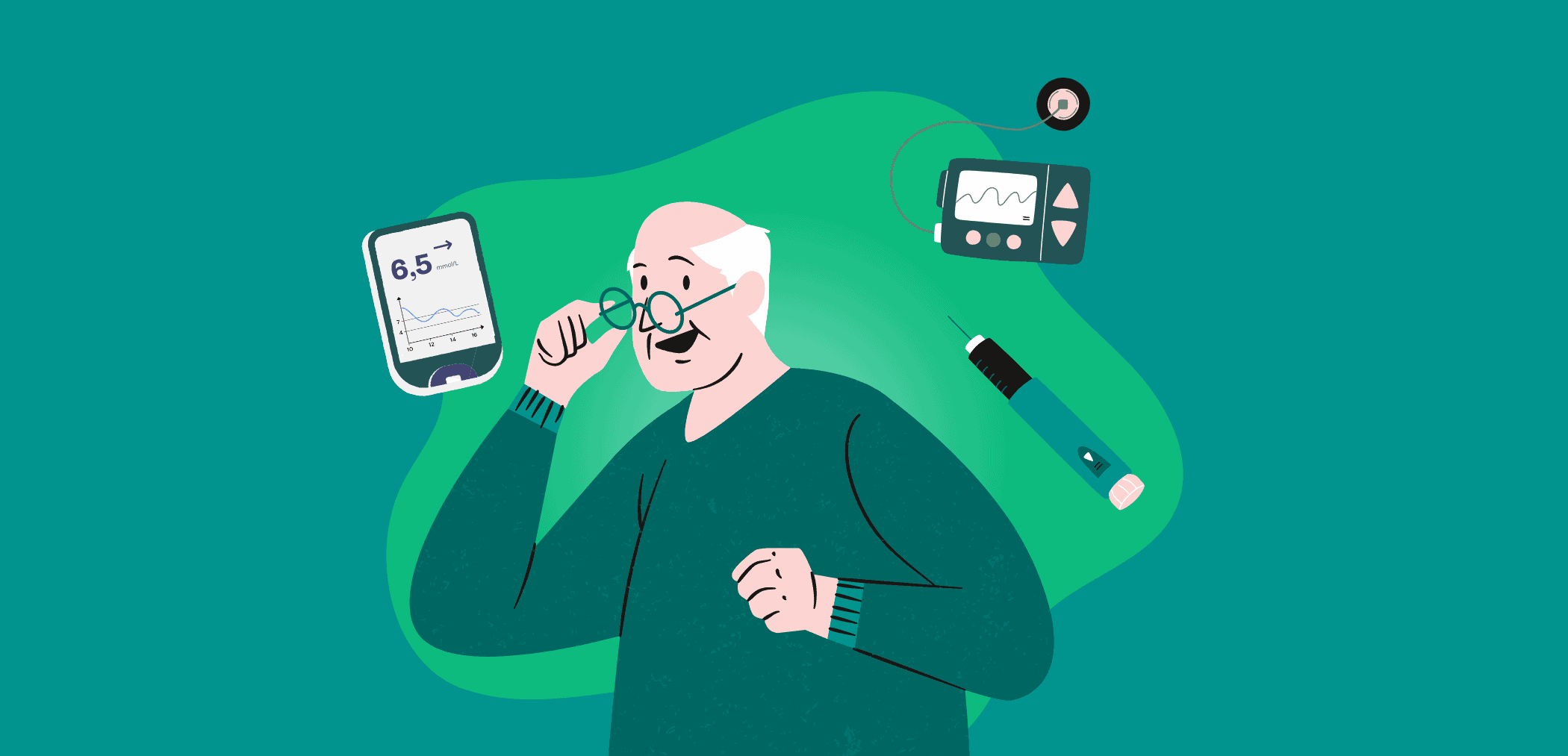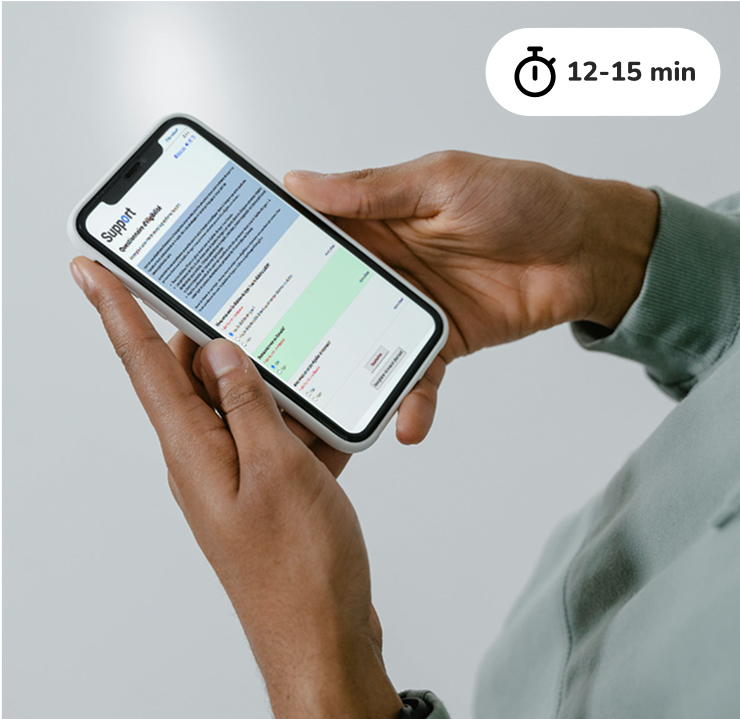Aging is an important concern for people living with type 1 diabetes (T1D). With increasing life expectancy and a growing number of adult-onset diagnoses, including among those aged 65 and older, it has become essential to understand how to age well with this condition.
Fortunately, it is possible to age well with T1D. Maintaining blood glucose within target (4–10 mmol/L), avoiding tobacco, managing blood pressure and cholesterol, limiting alcohol, and engaging in regular physical activity are proven strategies. Thanks to these approaches, the number of people aging with T1D without major complications continues to rise.
Adapting care to age and ability
As we age, our bodies change. While some people age in good health and maintain their independence, others may face problems such as cognitive impairment, reduced manual, visual or auditory dexterity, brittle bones (osteoporosis), a predisposition to falls, associated diseases and new medications that may interfere with blood sugar levels, or an increased risk of hospitalization.
Not only do these changes in health status reduce one’s quality of life, they also complicate diabetes self-management. The American Diabetes Association recommends that screening for health complications related to ageing and diabetes be individualized and performed periodically after 65. In fact, the ability to perform everyday tasks matters more than age alone.
Watching for hypoglycemia
The risk of hypoglycemia unawareness increases with age and with the number of years with T1D, and so does the risk of severe hypoglycemia.
In turn, hypoglycemia can increase the risk of falls, injury and hospitalization, as well as reduce quality of life at any age; however, these can have a bigger impact on seniors. When hypoglycemia becomes more frequent or comes with more severe “side effects” (e.g., loss of consciousness, numerous falls with injury, extreme fatigue), target blood sugar levels can be revised to reduce the risk of hypoglycemia. For example, if you use a continuous glucose monitoring (CGM) system (e.g., Dexcom, FreeStyle Libre, Guardian), your medical team may suggest that you aim for 50% time in range (instead of the usual 70%), and less than 1% of your time in hypoglycemia (instead of the usual 4%).
In short, it’s important to remember that as we get older, it is even more important to prevent hypoglycemia, even if it means tolerating average blood sugar levels that are slightly higher than usual. Indeed, after a certain age, it’s no longer as crucial to aim for optimal blood sugar levels to reduce the risk of possible complications in the next 10 or 20 years.

Supporting the use of technologies
Several studies have shown that the use of technology in the treatment of diabetes leads to better blood sugar management and fewer hypoglycemic episodes. The ability to use these tools’ advanced functions (e.g., adjusting settings) is similar across the different age groups.
Most major diabetes associations and experts recommend that access to a CGM and a hybrid closed-loop system (artificial pancreas) for all people living with T1D be facilitated, as long as they wish to do so and feel capable of managing these tools, regardless of age.
With the help of a loved one, even people with impaired dexterity, vision or hearing can use these technologies. For example, a loved one can set up the CGM. Seniors with T1D can track their blood sugar data on a cell phone and use features such as character enlargement or brightness contrasts. Alarm settings can also be adjusted (e.g., blood sugar threshold, alarm volume) and shared with a friend or family member.
Manufacturers should consider simplicity and ergonomics in terms of software and hardware, for instance, by offering buttons that are easier to manipulate for older people or those with physical limitations.
The financial burden of T1D must also be taken into account. As you get older, you may see a drop in income and lose your private insurance, which can limit your ability to afford the significant costs of certain technologies.
According to preliminary BETTER registry data currently being analyzed, more than a third of people aged 60 and over use an insulin pump, which is similar to the 50–59 age group.
About 70% of those aged 70 and over use a CGM, compared with 83–84% of those aged 50 to 69.
Staying on the lookout for possible complications
Other than the usual diabetes-related complications (e.g., eye, kidney, nerve and heart damage), some health problems associated with T1D may arise with age. In addition to the usual screenings (e.g., fundus, kidney function), it is strongly suggested to monitor the increased risk of:
- Fragile bones, or osteoporosis, which increases the risk of fractures. It’s important to note that this complication usually affects women in greater numbers, but it also affects men living with T1D in a comparable way.
- Falls due to hypoglycemia, nerve damage (neuropathy) or reduced sensation caused by a deformation of bones in the foot, or the effects of certain medications (e.g., sleeping pills or certain blood pressure treatments).
- Memory loss, either temporarily during a hypoglycemic episode, or close to permanent, which increases the risk of errors in insulin dose adjustment. For people who use injections, it is recommended to use a pen with a memory function for the last dose. Smart pens (connected to a cell phone) that automatically record up to 800 injections (dose, time since last dose) should be available in Canada in the next few months, making diabetes management even easier.
The good news is that many of the strategies that help reduce the risk of the usual diabetes-related complications (e.g., eyes, kidneys) have the same positive impact on these common age-related problems. As a reminder, these strategies are:
- Good blood sugar management, made easier with new tools (new insulin types and technologies).
- Blood pressure and cholesterol under control, with medication if necessary. Data from the BETTER registry show that over 70% of people who should benefit from these drugs actually take them.
- Regular physical activity, for instance, aiming for at least 7,000 steps a day or the equivalent of an hour’s walk a day at a moderate pace (100 steps/min), or 40 minutes at a rapid pace.
- No smoking.
- Balanced diet that includes fruit, vegetables, sufficient calcium and vitamin D, and as few ultra-processed foods as possible.
Aging in health… yes, it’s possible!
Research suggests that distress and stigma related to T1D decrease with age or longer diabetes management experience. The BETTER registry shows that more people are living past 65 without major complications, without frequent hypoglycemia, able to use technology, and with less worry about hypoglycemia.
These data help reshape perceptions about aging with T1D: aging with minimal complications is achievable, and technology can be used effectively at any age.
Do you want to contribute to research and share your experience of aging with T1D? Sign up for the registry! Your participation also helps advocate for equitable access to diabetes management technologies, a crucial issue as income often declines after retirement.
To find out more:
- BETTER webinar Aging with type 1 diabetes: assessment and preparation.
- BETTER webinar Bone health and type 1 diabetes.
References:
- Prévost, G. et al. (2023). Les personnes âgées vivant avec un diabète de type 1: Older adults living with type 1 diabetes. Médecine des Maladies Métaboliques 17(8) S1 : 8S38-8S42. https://www.sciencedirect.com/science/article/pii/S195725572300295X
- Diabète Canada. Le diabète chez les personnes âgées – Lignes directrices de pratique clinique 2018. Canadian Journal of Diabetes 42 : S283-S295. https://guidelines.diabetes.ca/GuideLines/media/Docs/french/37-Diabetes-in-Older-People-fr.pdf
- Diabète Canada. Neuropathie – Ligne directrice de pratique clinique 2018. Canadian Journal of Diabetes 42 : S217-S221. https://guidelines.diabetes.ca/GuideLines/media/Docs/french/31-Neuropathy-FR.pdf
- American Diabetes Association. Older adults: Standards of Care in Diabetes – 2024. Diabetes Care 47(S. 1) : S244-S257. https://diabetesjournals.org/care/article/47/Supplement_1/S244/153944/13-Older-Adults-Standards-of-Care-in-Diabetes-2024
- TIRhub.ca. Rapport de Consensus international sur le temps dans la cible. Page consultée le 13 mai 2024. https://tirhub.ca/fr/rapport-de-consensus-international/
- Kammoun, F. et al. (2023). Impact de la neuropathie diabétique sur la qualité de vie des patients âgés. Annales d’Endocrinologie 84(1) : 202. https://www.sciencedirect.com/science/article/abs/pii/S0003426622012203
- Madar, H. et al. (2023). Cardiovascular Risk Factors and Adherence to Cardiovascular Protection Practice Guidelines in Adults With Type 1 Diabetes: A BETTER Registry Cross-sectional Analysis. Can. J. Diabetes 47(6): 473-481.e.1. https://www.canadianjournalofdiabetes.com/article/S1499-2671(23)00069-2/abstract
- Citoyenneté et Immigration Canada. (2013). Néphropathie. Page consultée le 14 mai 2024. https://www.canada.ca/content/dam/ircc/migration/ircc/francais/ministere/partenariat/md/pdf/iemi_nephropathie.pdf
Written by: Nathalie Kinnard, scientific writer and research assistant
Reviewed by:
- Rémi Rabasa-Lhoret, MD, Ph.D.
- Sarah Haag, R.N., B.Sc.
- Anne-Sophie Brazeau, P.Dt., Ph.D.
- Eve Poirier, Claude Laforest, Jacques Pelletier, Aude Bandini et Michel Dostie, patient partners of the BETTER project.




